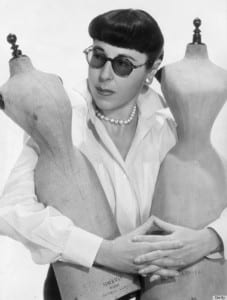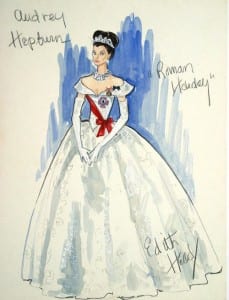You may not know the name but you will undoubtedly have seen her work before. Edith Head was an American costume designer who worked from 1924 when she was hired as a costume sketch artist by Paramount Pictures, until her death in 1981. She is also the woman who inspired Pixar’s The Incredibles character, Edna Mode.
When Head was hired by Paramount Pictures she had no art, design or costume design experience. She was only hired because she had borrowed sketches from art school classmates which impressed the head designer so much Head was hired on the spot.
Over her long career she amounted eight Academy Awards for Best Costume Design from 35 nominations, a feat which no one else has matched. It is important to note that the first Academy Award for Best Costume Design wasn’t given until 1948, already well into Head’s career and that her eight awards are the most Oscars ever won by one woman.
Head designed for numerous actresses on over 1000 productions, creating gowns for all of Hollywood’s golden girls. Some of the most notable are; Veronica Lake, Ginger Rogers, Elizabeth Taylor, Audrey Hepburn, Grace Kelly, Sophia Loren, Tippi Hedren and Katharine Hepburn.
Perhaps the most outstanding work from Head are her designs in collaboration with Alfred Hitchcock. Head designed for 11 of the directors films in her later career including The Birds (1963). Head designed Tippi Hedren’s pale green skirt suit which has become an icon of the film and style of the time.
10 years earlier, Head was also costume designer for Roman Holiday (1953), Audrey Hepburn’s breakthrough film. In the film Hepburn plays a princess tired of her boring and restricted life, she escapes her guardians and falls for an American newsman in Rome.
In the below film, Edith Head answers the question “How do you go about changing actresses appearances with their wardrobe?” by discussing the work she had done on Roman Holiday with Hepburn. Her first costume is a ‘casual, informal’ which she wears while pretending she is not a princess. Head then describes her transformation to a princess in a regal dress, of ‘real lace’ as head called ‘transformation through wardrobe’.
Although Head actually won the Academy Award for Best Costume Design in Sabrina (1954), Audrey Hepburn’s costumes were actually designed by Givenchy who was uncredited. Head was hired as costume designer for Sabrina but was then told that Hepburn was having Givenchy design all of her gowns which was quite an offence to such an established costume designer. To prevent Head from quitting the film, director Billy Wilder and Paramount Pictures gave her full screen credit for Costume Designer.
Givenchy got his own back in 1961 for Breakfast at Tiffany’s. Again Givenchy designed all of Hepburn’s gowns while Head designed all of the other characters costumes (bar Patricia Neal), but Givenchy ensured that Head was only credited as ‘wardrobe supervisor’ which was an insult to a designer of her stature.
Edith Head’s packed career is one unlikely to ever be rivalled. The costume designer is immortalised in her creations which span over half a century, and adorned Hollywood more glamorous actresses for decades.




